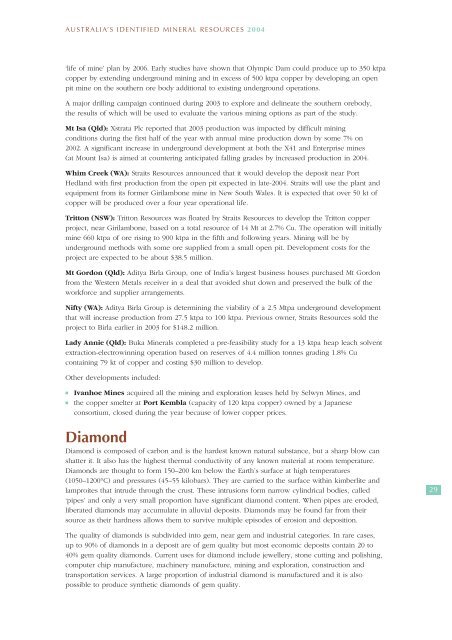australia's identified mineral resources 2004 - Geoscience Australia
australia's identified mineral resources 2004 - Geoscience Australia
australia's identified mineral resources 2004 - Geoscience Australia
Create successful ePaper yourself
Turn your PDF publications into a flip-book with our unique Google optimized e-Paper software.
AUSTRALIA’S IDENTIFIED MINERAL RESOURCES <strong>2004</strong><br />
‘life of mine’ plan by 2006. Early studies have shown that Olympic Dam could produce up to 350 ktpa<br />
copper by extending underground mining and in excess of 500 ktpa copper by developing an open<br />
pit mine on the southern ore body additional to existing underground operations.<br />
A major drilling campaign continued during 2003 to explore and delineate the southern orebody,<br />
the results of which will be used to evaluate the various mining options as part of the study.<br />
Mt Isa (Qld): Xstrata Plc reported that 2003 production was impacted by difficult mining<br />
conditions during the first half of the year with annual mine production down by some 7% on<br />
2002. A significant increase in underground development at both the X41 and Enterprise mines<br />
(at Mount Isa) is aimed at countering anticipated falling grades by increased production in <strong>2004</strong>.<br />
Whim Creek (WA): Straits Resources announced that it would develop the deposit near Port<br />
Hedland with first production from the open pit expected in late-<strong>2004</strong>. Straits will use the plant and<br />
equipment from its former Girilambone mine in New South Wales. It is expected that over 50 kt of<br />
copper will be produced over a four year operational life.<br />
Tritton (NSW): Tritton Resources was floated by Straits Resources to develop the Tritton copper<br />
project, near Girilambone, based on a total resource of 14 Mt at 2.7% Cu. The operation will initially<br />
mine 660 ktpa of ore rising to 900 ktpa in the fifth and following years. Mining will be by<br />
underground methods with some ore supplied from a small open pit. Development costs for the<br />
project are expected to be about $38.5 million.<br />
Mt Gordon (Qld): Aditya Birla Group, one of India’s largest business houses purchased Mt Gordon<br />
from the Western Metals receiver in a deal that avoided shut down and preserved the bulk of the<br />
workforce and supplier arrangements.<br />
Nifty (WA): Aditya Birla Group is determining the viability of a 2.5 Mtpa underground development<br />
that will increase production from 27.5 ktpa to 100 ktpa. Previous owner, Straits Resources sold the<br />
project to Birla earlier in 2003 for $148.2 million.<br />
Lady Annie (Qld): Buka Minerals completed a pre-feasibility study for a 13 ktpa heap leach solvent<br />
extraction-electrowinning operation based on reserves of 4.4 million tonnes grading 1.8% Cu<br />
containing 79 kt of copper and costing $30 million to develop.<br />
Other developments included:<br />
■<br />
■<br />
Ivanhoe Mines acquired all the mining and exploration leases held by Selwyn Mines, and<br />
the copper smelter at Port Kembla (capacity of 120 ktpa copper) owned by a Japanese<br />
consortium, closed during the year because of lower copper prices.<br />
Diamond<br />
Diamond is composed of carbon and is the hardest known natural substance, but a sharp blow can<br />
shatter it. It also has the highest thermal conductivity of any known material at room temperature.<br />
Diamonds are thought to form 150–200 km below the Earth’s surface at high temperatures<br />
(1050–1200°C) and pressures (45–55 kilobars). They are carried to the surface within kimberlite and<br />
lamproites that intrude through the crust. These intrusions form narrow cylindrical bodies, called<br />
‘pipes’ and only a very small proportion have significant diamond content. When pipes are eroded,<br />
liberated diamonds may accumulate in alluvial deposits. Diamonds may be found far from their<br />
source as their hardness allows them to survive multiple episodes of erosion and deposition.<br />
29<br />
The quality of diamonds is subdivided into gem, near gem and industrial categories. In rare cases,<br />
up to 90% of diamonds in a deposit are of gem quality but most economic deposits contain 20 to<br />
40% gem quality diamonds. Current uses for diamond include jewellery, stone cutting and polishing,<br />
computer chip manufacture, machinery manufacture, mining and exploration, construction and<br />
transportation services. A large proportion of industrial diamond is manufactured and it is also<br />
possible to produce synthetic diamonds of gem quality.

















